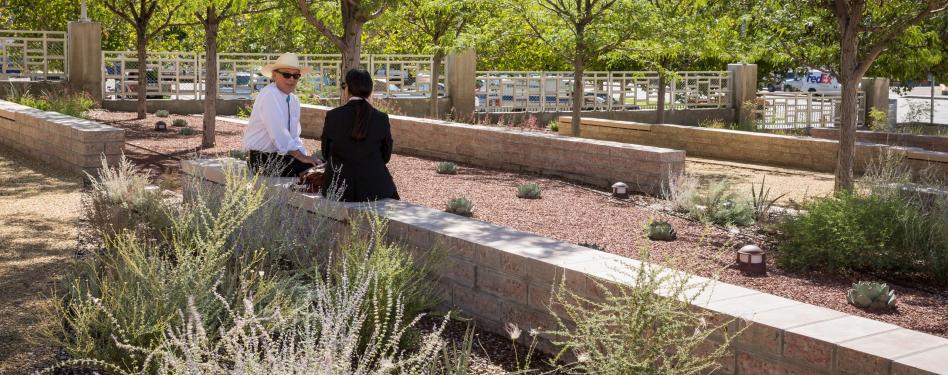
Feature image: The SITES-certified Pete V. Domenici U.S. Courthouse Sustainable Landscape Renovation in Albuquerque, New Mexico. Photo credit: Robert Reck.
Since its launch 25 years ago, LEED has focused on promoting thoughtful choices in building operations, design and construction. Influenced by LEED’s goal to transform the market and improve green building practices, SITES set out in 2006 to elevate the value of nature and its ecosystem services in the built environment by advancing regenerative design, resilience and nature-based solutions. SITES projects using the SITES v2 rating system currently span 25 countries and 42 U.S. states, as well as Washington, D.C.
Complementary rating systems
SITES and LEED are administered by GBCI, and the rating systems are complementary, allowing them to be used independently or in tandem. While LEED for Building Design and Construction (LEED BD+C) focuses primarily on a building and the site on which it is located, SITES works for projects with or without buildings, focusing its attention on the site and landscape, and only including the building in a few exceptions (e.g., green walls or roofs on buildings). The SITES v2 rating system applies to new construction projects as well as existing sites undergoing major renovation and is being applied to a wide variety of projects, from university campuses, mixed-use developments and corporate headquarters to parks and infrastructure.
LEED v5 introduces a new framework centered on three impact areas—decarbonization, quality of life, and ecological conservation and restoration—while SITES is recognized for its ecological focus and its positive effects on community quality of life. As a result, the links between LEED and SITES are stronger than ever, and there is now an exciting opportunity to pursue certifications that support these impact areas in both buildings and their surrounding landscapes.
Pursuing SITES and LEED
If you would like your project to benefit from both SITES and LEED v5 BD+C certification, you can take advantage of the synergies outlined in a newly released crosswalk. The crosswalk outlines both one- and two-way achievement options between credits of the LEED v5 BD+C and SITES v2 rating systems. By simplifying the documentation and submission process, the crosswalks help projects that pursue both certifications simultaneously or in quick succession (for the best outcome, apply the systems concurrently). The crosswalk will be updated periodically, and future versions may address additional synergies and aligned documentation opportunities.
Examples of highlighted credit synergies in the LEED v5 and SITES v2 crosswalk include
- Reducing urban heat island effects.
- Reducing light pollution.
- Increasing on-site carbon sequestration.
- Reducing wildfire risk as part of enhancing resilient site design.
While the LEED and SITES applications for certification are submitted through their respective portals, in most cases, the same reviewer will be assigned to both when they are for the same project. This streamlines communication and the overall process.
The LEED v5 and SITES v2 crosswalk follows the publication of the LEED to SITES Readiness Tool, released in 2021, which is applicable to LEED v4 BD+C and SITES v2 projects.
